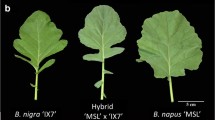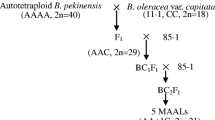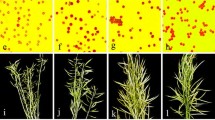Abstract
The intertribal sexual hybrids between three Brassica napus (2n = 38) cultivars and Lesquerella fendleri (2n = 12) with the latter as pollen parent were obtained and characterized for their phenotypes and chromosomal and genomic constitutions. F1 plants and their progenies mainly resembled female B. napus parents, while certain characters of L. fendleri were expressed in some plants, such as longer flowering period, basal clustering stems and particularly the glutinous layer on seed coats related to drought tolerance. Twenty-seven F1 plants were cytologically classified into five types: type I (16 plants) had 2n = 38, type II (2) had 2n = 38–42, type III (3) had 2n = 31–38, type IV (5) had 2n = 25–31, and type V (1) had 2n = 19–22. Some hybrids and their progenies were mixoploids in nature with only 1–2 chromosomes or some chromosomal fragments of L. fendleri included in their cells. AFLP (Amplified fragments length polymorphism) analysis revealed that bands absent in B. napus, novel for two parents and specific for L. fendleri appeared in all F1 plants and their progenies. Some progenies had the modified fatty acid profiles with higher levels of linoleic, linolenic, eicosanoic and erucic acids than those of B. napus parents. The occurrence of these partial hybrids with phenotypes, genomic and fatty acid alterations resulted possibly from the chromosome elimination and doubling accompanied by the introgression of alien DNA segments and genomic reorganization. The progenies with some useful traits from L. fendleri should be new and valuable resource for rapeseed breeding.



Similar content being viewed by others
References
Barclay AS, Gentry HS, Jones Q (1962) The search for new industrial crops II. Lesquerella (Cruciferae) as a source of new oilseeds. Econ Bot 16:95–100
Bassam B, Caetano-Anolles G, Gresshoff PM (1991) Fast and sensitive silver staining of DNA in polyacrylamide gels. Anal Biochem 196:80–83
Broun P, Boddupalli S, Somerville C (1998) A bifunctional oleate 12-hydroxylase: desaturase from Lesquerella fendleri. Plant J 13(2):201–210
Carlson KD, Bagby M, Chaudry A (1990) Analysis of oil and meal from Lesquerella fendleri seed. J Am Oil Chem Soc 67:438–442
Chen HF, Wang H, Li ZY (2007) Production and genetic analysis of partial hybrids in intertribal crosses between Brassica species (B. rapa, B. napus) and Capsella bursa-pastoris. Plant Cell Rep. DOI 10.1007/s00299-007-0392-x
Chrungu B, Verma N, Mohanty A, Pradhan A, Shivanna KR (1999) Production and characterization of interspecific hybrids between Brassica maurorum and crop brassicas. Theor Appl Genet 98:608–613
Dellaporta SL,Wood J, Hicks JB (1983) A plant DNA mini preparation: version II. Plant Mol Biol Rep 1:19–21
Faure N, Serieys H, Berville A, Cazaux E, Keen F (2002)Occurrence of partial hybrids in wide crosses between sunflower (Helianthus annuus) and perennial species H. mollis and H. orgyalis. Theor Appl Genet 104:652–660
Gernand D, Rutten T, Varshney A, Rubtsova M, Prodanovic S, Bru¨ss C, Kumlehn J, Matzk F, Houben A (2006) Uniparental chromosome elimination at mitosis and interphase in wheat and pearl millet crosses involves micronucleus formation, progressive heterochromatinization and DNA fragmentation. Plant Cell 17: 2431–2438
Glimelius K (1999) Somatic hybridization. In: Gómez-Campo C (ed) Biology of Brassica coenospecies. Elsevier, Amsterdam, pp 107–148
Harlan JR, de Wet JMJ (1971) Toward a rational classification of cultivated plants. Taxon 20:509–517
Hua YW, Liu M, Li ZY (2006) Parental genome separation and elimination of cells and chromosomes revealed by GISH and AFLP analyses in a Brassica carinata × Orychophragmus violaceus cross. Ann Bot 97:993–998
Jin WW, Melo JR, Nagaki K, Talbert PB, Henikoff S, Dawe RK, Jiang JM (2004) Maize centromeres: organization and functional adaptation in the genetic background of oat. Plant Cell 16:571–581
Kleiman R (1990) Chemistry of new industrial oilseed crops [M]. In: Janick J, Simon JE (eds) Advances in new crops. Timber Press, Portland OR pp 196–203
Leflon M, Eber F, Letanneur JC, Chelysheva L, Coriton O, Huteau V, Ryder CD, Barker G, Jenczewski E, Chevre AM (2006) Pairing and recombination at meiosis of Brassica rapa (AA) × Brassica napus (AACC) hybrids. Theor Appl Genet 113:1467–1480
Leitch AR, Schwarzacher T, Jackson D, Leitch IJ (1994) Microscopy handbook No. 27. In situ hybridization: a practical guide. Bios Scientific, Oxford
Li Z, Liu HL, Luo P (1995) Production and cytogenetics of intergeneric hybrids between Brassica napus and Orychophragmus violaceus. Theor Appl Genet 91: 131–136
Li Z, Wu JG, Liu Y, Liu HL, Heneen WK (1998) Production and cytogenetics of intergeneric hybrids Brassica juncea × Orychophragmus violaceus and B. carinata × O. violaceus. Theor Appl Genet 96:251–265
Liu M, Li ZY (2007) Genome doubling and chromosome elimination with fragment recombination leading to the formation of Brassica rapa-type plants with genomic alterations in crosses with Orychophragmus violaceus. Genome (in press)
Liu B, Wendel JF (2003) Epigenetic phenomena and the evolution of plant allopolyploids. Mol Phylogenet Evol 29:365–379
Liu B, Piao HM, Zhao PS, Zhao JH, Zhao R (1999) Production and molecular characterization of rice lines with introgressed traits from a wild species Zizania latifolia (Griseb). J Genet Breed 53:279–284
Luo P, Fu HL, Lan ZQ, Zhou SD, Zhou HF, Luo Q (2003) Phytogenetics studies on intergeneric hybridization between Brassica napus and Matthiola incana. Acta Bot Sin 45(4):432–436
Madlung A, Comai L (2004) The effect of stress on genome regulation and structure. Ann Bot 94:481–495
McClintock B (1984) The significant of responses of the genome to challenge. Science 226:792–801
Mitchell RJ (1997) Effects of pollination intensity on Lesquerella fendleri seed set: variation among plants. Oecologia 109:382–388
Murashige T, Skoog F (1962) A revised medium for rapid growth and bioassay with tobacco tissue cultures. Physiol Plant 15:473–479
Prakash S, Takahata Y, Kirti PB, Chopra V (1999) Cytogenetics. In: Gomez-Campo C (ed) Biology of Brassica coenospecies. Elsevier, Amsterdam, pp 59–106
Riera-Lizarazu O, Rines HW, Phillips RL (1996) Cytological and molecular characterization of oat × maize partial hybrids. Theor Appl Genet 93:123–135
Roetheli JC, Carlson KC, Kleiman R, Thompson AE, Dierig DA, Glaser LK, Blase MG, Goodell J (1991) Lesquerella as a source of hydroxyl fatty acids for industrial products. An assessment. USDA/CSRS Office of Agricultural Materials, Washington
Schroder-Pontoppidan M, Skarzhinskaya M, Dixelius C , Stymne S , Glimelius K (1999) Very long chain and hydroxylated fatty acids in offspring of somatic hybrids between Brassica napus and Lesquerella fendleri. Theor Appl Genet 99:108–114
Shan XH, Liu ZL, Dong ZY, Wang YM, Chen Y, Lin XY, Long LK, Han FP, Dong YS, Liu B (2005) Mobilization of the active mite transposons mPing and Pong in rice by introgression from wild rice (Zizania latifolia Griseb.). Mol Biol Evol 22: 976–990
Skarzhinskaya M, Landgren M, Glimelius K (1996) Production of intertribal somatic hybrids between Brassca napus and lequerella fendleri (Gray) Wats. Theor Appl Genet 93:242–1250
Skarzhinskaya M, Fahleson J, Glimelius K, Mouras A (1998) Genome organization of Brassica napus and Lesquerella fendleri and analysis of their somatic hybrids using genomic in situ hybridisation. Genome 41:691–701
Snowdon RJ, Winter H, Diestel A, Sacristán MD (2000) Development and characterisation of Brassica napus-Sinapis arvensis addition lines exhibiting resistance to Leptosphaeria maculans. Theor Appl Genet 101:1008–1014
Thompson AE, Dierig DA (1988) Lesquerella—a new arid land industrial oil seed crop. EI Guayulero 10:16–18
Vos P, Hogers R, Bleeker M, Reijans M, van de Lee T, Hornes M, Frijters A, Pot J, Peleman J, Kuiper M, Zabeau M (1995) AFLP: a new technique for DNA fingerprinting. Nucleic Acids Res 23:4407–4414
Voss A, Snowdon RJ, Lühs W, Friedt W (2000) Intergeneric transfer of nematode resistance from Raphanus sativus into the Brassica napus genome. Acta Hortic 539:129–134
Warwick SI, Francis A, La Fleche J (2000) Guide to the wild germplasm of Brassica and allied crops (tribe Brassiceae, Brassicaceae). 2nd ed. Agriculture and Agri-Food Canada, Eastern Cereal and Oilseed Research Centre, Ottawa
Wang YP, Sonntag K, Rudloff E (2003) Development of rapeseed with high erucic acid content by asymmetric somatic hybridization between Brassica napus and Crambe abyssinica. Theor Appl Genet 106:1147–1155
Wang YM, Dong ZY, Zhang ZJ, Lin XY, Shen Y, Zhou DW, Liu B (2005) Extensive de novo genomic variation in rice induced by introgression from wild rice (Zizania latifolia Griseb.). Genetics 170:1945–1956
Wang J, Tian L, Madlung A, Lee HS , Chen M, Lee JJ, Watson B, Kagochi T, Comai L, Chen ZJ (2004) Stochastic and epigenetic changes of expression in Arabidopsis polyploids. Genetics 167:1961–1973
Zhong XB, Hans de Jong J, Zabel P (1996) Preparation of tomato meiotic pachytene and mitotic metaphase chromosomes suitable for fluorescence in situ hybridization (FISH). Chromosome Res 4:24–28
Acknowledgments
The study was supported by “948” Project of Agricultural Ministry of China and by PCSIRT (IRT0442).
Author information
Authors and Affiliations
Corresponding author
Additional information
Communicated by K. Toriyama.
Rights and permissions
About this article
Cite this article
Du, XZ., Ge, XH., Zhao, ZG. et al. Chromosome elimination and fragment introgression and recombination producing intertribal partial hybrids from Brassica napus × Lesquerella fendleri crosses. Plant Cell Rep 27, 261–271 (2008). https://doi.org/10.1007/s00299-007-0452-2
Received:
Revised:
Accepted:
Published:
Issue Date:
DOI: https://doi.org/10.1007/s00299-007-0452-2




